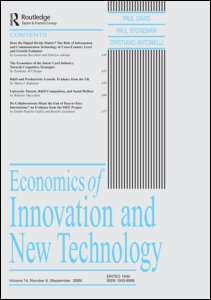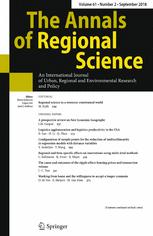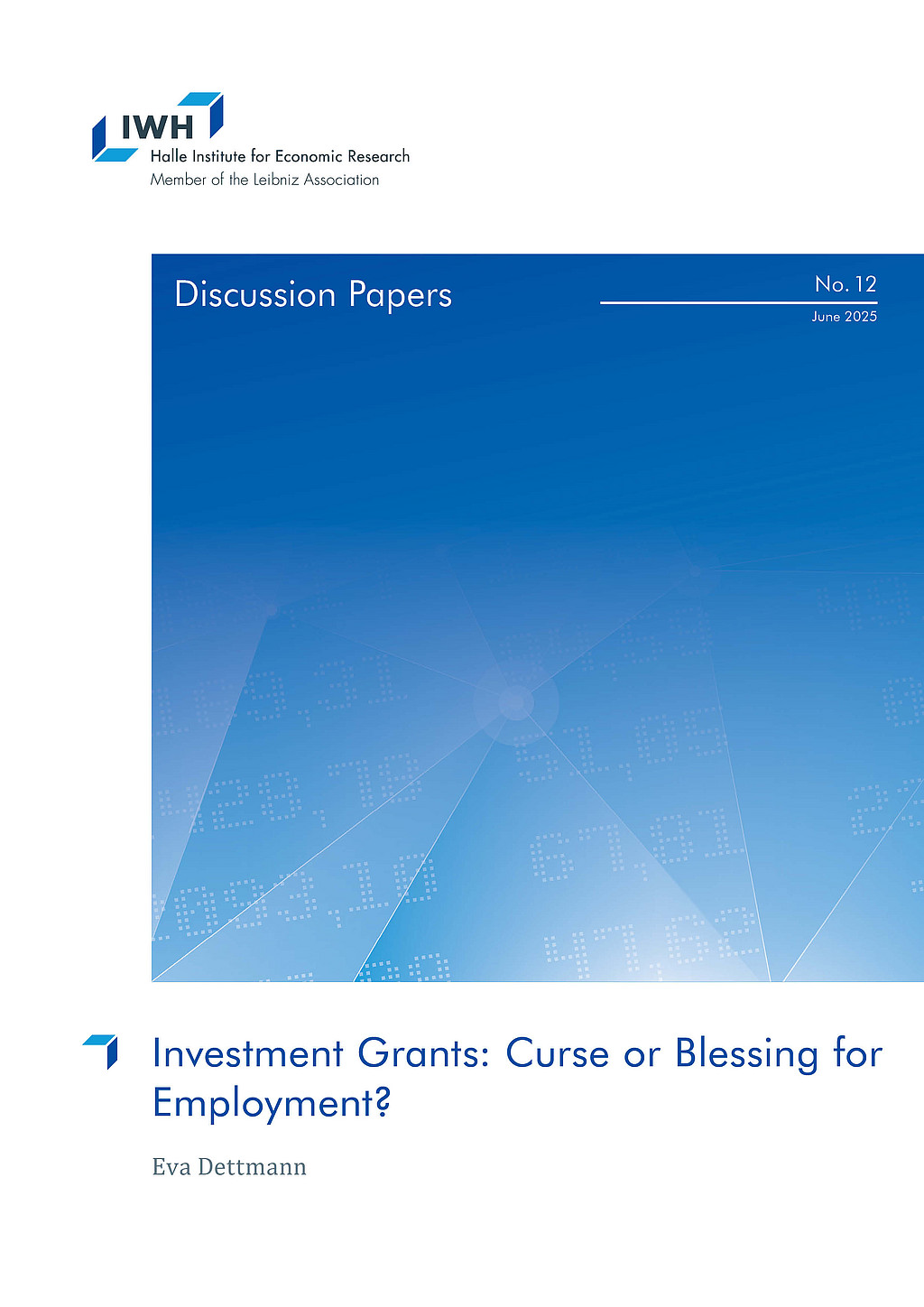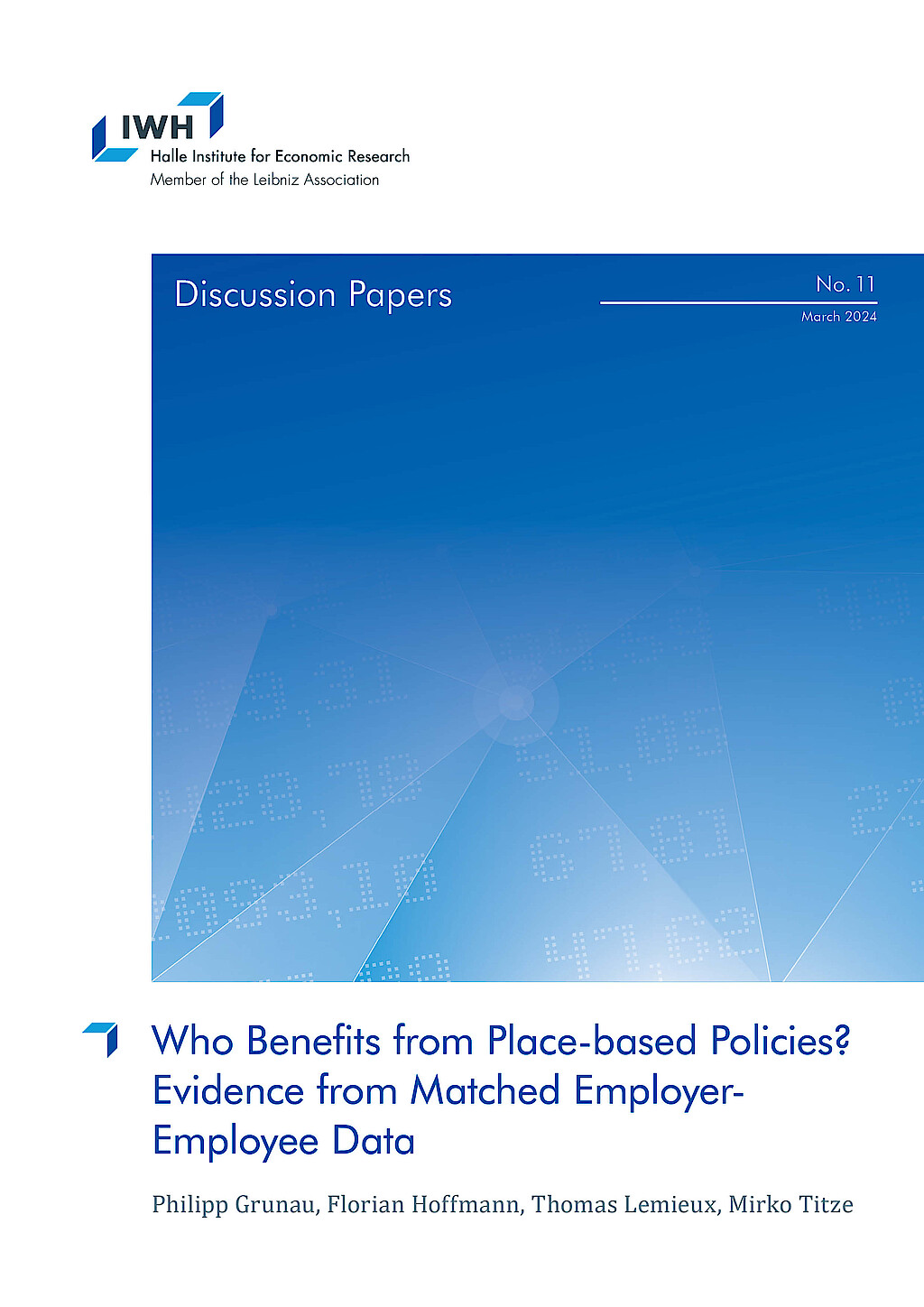Evaluierung von Subventionsprogrammen
Diese Forschungsgruppe untersucht die Effekte von Produktions- und Wissensnetzwerken auf die Produktivität von Unternehmen und Regionen. Darüber hinaus werden Wirkungen staatlicher Förderprogramme für Forschung und Entwicklung sowie regionalpolitischer Programme auf die Leistungsfähigkeit von Unternehmen und Regionen evaluiert.
Zentrum für evidenzbasierte Politikberatung (IWH-CEP)
Forschungscluster
Wirtschaftliche Dynamik und StabilitätIhr Kontakt

- Abteilung Zentrum für evidenzbasierte Politikberatung
PROJEKTE
09.2019 ‐ 09.2022
Etablierung einer evidenzbasierten Evaluationskultur für industriepolitische Fördermaßnahmen in Deutschland (EVA-KULT)
Europäischer Fonds für regionale Entwicklung (EFRE)
Das Vorhaben dient dem Ausbau des Zentrums für evidenzbasierte Politikberatung am Leibniz-Institut für Wirtschaftsforschung Halle (IWH-CEP).
01.2018 ‐ 12.2020
Vernetzt wachsen - Innovatives Sachsen-Anhalt durch digitale Geschäftsmodelle (Kompetenzzentrum 4.0)
Bundesministerium für Wirtschaft und Energie (BMWi)
01.2017 ‐ 12.2018
Politische Partizipation in Ostdeutschland
Bundesministerium für Wirtschaft und Energie (BMWi)
12.2015 ‐ 11.2018
Sozioökonomische Effekte der Erforschung innovativer Ansätze für die POC-Diagnostik
Bundesministerium für Bildung und Forschung (BMBF)
Teilvorhaben im Verbundprojekt “POC-Sensorplattform für chronisch-entzündliche Atemwegserkrankungen (EXASENS)”. Neun Leibniz-Institute arbeiten gemeinsam im Pilotprojekt EXASENS an der Erforschung einer Point-of-Care-Technologie zur Vorhersage und Diagnose von chronisch-entzündlichen Atemwegserkrankungen. Der Verbund wird vom Bundesministerium für Bildung und Forschung (BMBF) mit 6,25 Millionen Euro gefördert und liefert einen Beitrag zum Ausbau und zur Stärkung des Themenfeldes Gesundheitstechnologien.
Vgl. Pressemitteilung des Leibniz-Institut für Photonische Technologien (IPHT), Jena.
02.2017 ‐ 02.2018
Bedeutung außeruniversitärer Forschungseinrichtungen für die Entwicklung von Betrieben und Regionen
Bundesministerium für Bildung und Forschung (BMBF)
01.2015 ‐ 12.2016
Evaluierung der GRW-Förderung in Sachsen-Anhalt
Investitionsbank Sachsen-Anhalt
Referierte Publikationen

Unemployment in the Great Recession: A Comparison of Germany, Canada, and the United States
in: Journal of Labor Economics, S1 Part 2 2016
Abstract
This paper looks at the surprisingly different labor market performance of the United States, Canada, Germany, and several other OECD countries during and after the Great Recession of 2008–9. A first important finding is that the large employment swings in the construction sector linked to the boom and bust in US housing markets is an important factor behind the different labor market performances of the three countries. We also find that cross-country differences among OECD countries are consistent with a conventional Okun relationship linking gross domestic product growth to employment performance.

The Structure and Evolution of Inter-sectoral Technological Complementarity in R&D in Germany from 1990 to 2011
in: Journal of Evolutionary Economics, Nr. 4, 2015
Abstract
Technological complementarity is argued to be a crucial element for effective R&D collaboration. The real structure is, however, still largely unknown. Based on the argument that organizations’ knowledge resources must fit for enabling collective learning and innovation, we use the co-occurrence of firms in collaborative R&D projects in Germany to assess inter-sectoral technological complementarity between 129 sectors. The results are mapped as complementarity space for the Germany economy. The space and its dynamics from 1990 to 2011 are analyzed by means of social network analysis. The results illustrate sectors being complements both from a dyadic and portfolio/network perspective. This latter is important, as complementarities may only become fully effective when integrated in a complete set of different knowledge resources from multiple sectors. The dynamic perspective moreover reveals the shifting demand for knowledge resources among sectors at different time periods.

R&D Cooperation with Scientific Institutions: A Difference-in-difference Approach
in: Economics of Innovation and New Technology, Nr. 5, 2016
Abstract
Economists and business managers have long been interested in the impact of research and development (R&D) cooperation with scientific institutions on the innovation performance of firms. Recent research identifies a positive correlation between these two variables. This paper aims to contribute to the identification of the relationship between R&D cooperation with scientific institutions and the product and process innovation performance of firms by using a difference-in-difference approach. In doing so, we distinguish between two different types of scientific institutions: universities and governmental research institutes. For the econometric analyses, we use data from the German Community Innovation Survey. In total, data from up to 560 German service and manufacturing firms are available for the difference-in-difference analyses. The results suggest that R&D cooperation with universities and governmental research institutes has a positive effect on both product innovation and process innovation performance of firms.

On the Trail of Core–periphery Patterns in Innovation Networks: Measurements and New Empirical Findings from the German Laser Industry
in: Annals of Regional Science, Nr. 1, 2015
Abstract
It has been frequently argued that a firm’s location in the core of an industry’s innovation network improves its ability to access information and absorb technological knowledge. The literature has still widely neglected the role of peripheral network positions for innovation processes. In addition to this, little is known about the determinants affecting a peripheral actors’ ability to reach the core. To shed some light on these issues, we have employed a unique longitudinal dataset encompassing the entire population of German laser source manufacturers (LSMs) and laser-related public research organizations (PROs) over a period of more than two decades. The aim of our paper is threefold. First, we analyze the emergence of core–periphery (CP) patterns in the German laser industry. Then, we explore the paths on which LSMs and PROs move from isolated positions toward the core. Finally, we employ non-parametric event history techniques to analyze the extent to which organizational and geographical determinates affect the propensity and timing of network core entries. Our results indicate the emergence and solidification of CP patterns at the overall network level. We also found that the paths on which organizations traverse through the network are characterized by high levels of heterogeneity and volatility. The transition from peripheral to core positions is impacted by organizational characteristics, while an organization’s geographical location does not play a significant role.

R&D Collaboration for Environmental Innovation
in: International Journal of Innovation Management, Nr. 1, 2015
Abstract
FuE-Kooperationen spielen eine bedeutende Rolle bei der Schaffung von Umweltinnovationen. Allerdings zeigt uns die Literatur, dass FuE-Kooperationen nicht immer vorteilhaft sind. Daher ist eine differenziertere Betrachtungsweise des Einflusses von FuE-Kooperationen auf die Fähigkeit von Unternehmen, Umweltinnovationen hervorzubringen, notwendig. Das Papier untersucht diesen Zusammenhang und differenziert dabei nach verschiedenen Typen von Kooperationspartnern wie Kunden, Lieferanten, Universitäten, staatlichen Forschungseinrichtungen, Konkurrenten, Beratern und anderen Firmen innerhalb der gleichen Firmengruppe. Zudem wird der Frage nachgegangen, ob Diversität von Kooperationspartnern einen Einfluss auf die Umweltinnovationsfähigkeit von Unternehmen hat. Dabei werden Daten von 2337 deutschen Unternehmen für eine Regressionsanalyse verwendet. Deutlich wird, dass FuE-Kooperationen mit Kunden, Lieferanten, Universitäten, staatlichen Forschungseinrichtungen, Beratern und anderen Firmen innerhalb der gleichen Firmengruppe einen signifikant positiven Einfluss auf die Umweltinnovationsfähigkeit haben. FuE-Kooperationen mit Konkurrenten haben keinen signifikanten Einfluss. Die Diversität von FuE-Kooperationspartnern hat ebenfalls einen signifikant positiven Einfluss auf die Umweltinnovationsfähigkeit.
Arbeitspapiere

Investment Grants: Curse or Blessing for Employment?
in: IWH Discussion Papers, Nr. 12, 2025
Abstract
<p>In this study, establishment-level employment effects of investment grants in Germany are estimated. In addition to the quantitative effects, I provide empirical evidence of funding effects on different aspects of employment quality (earnings, qualifications, and job security) for the period 2004 to 2020. The database combines project-level treatment data, establishment-level information on firm characteristics and employee structure, and regional information at the district-level. For the estimations, I combine the difference-in-differences approach of Callaway and Sant’Anna (2021) with ties matching at the cohort level. The estimations yield positive effects on the number of employees, but point to contradicting effects of investment grants on different aspects of employment quality.</p>

Who Benefits from Place-based Policies? Evidence from Matched Employer-Employee Data
in: IWH Discussion Papers, Nr. 11, 2024
Abstract
<p>We study the granular wage and employment effects of a German place-based policy using a research design that leverages conditionally exogenous EU-wide rules governing program parameters at the regional level. The place-based program subsidizes investments to create jobs with a subsidy rate that varies across labor market regions. The analysis uses matched data on the universe of establishments and their employees, establishment-level panel data on program participation, and regional scores that generate spatial discontinuities in program eligibility and generosity. Spatial spillovers of the program linked to changing commuting patterns can be assessed using information on place of work and place of residence, a unique feature of the data. These rich data enable us to study the incidence of the place-based program on different groups of individuals. We find that the program helps establishments create jobs that disproportionately benefit younger and less-educated workers. Funded establishments increase their wages but, unlike employment, wage gains do not persist in the long run. Employment effects estimated at the local area level are slightly larger than establishment-level estimates, suggesting limited economic spillover effects. On the other hand, spatial spillovers are large as over half of the employment increase comes from commuters. Using subsidy rates as an instrumental variable for actual subsidies indicates that it costs approximately EUR 25,000 to create a new job in the economically disadvantaged areas targeted by the program.</p>

Employment Effects of Investment Grants and Firm Heterogeneity – Evidence from a Staggered Adoption Approach
in: IWH Discussion Papers, Nr. 6, 2023
Abstract
<p>This study estimates the firm-level employment effects of investment grants in Germany. In addition to the average treatment effect on the treated, we examine discrimination in the funding rules as potential source of effect heterogeneity. We combine a staggered difference-in-differences approach that explicitly models variations in treatment timing with a matching procedure at the cohort level. The findings reveal a positive effect of investment grants on employment development in the full sample. The subsample analysis yields strong evidence for heterogeneous effects based on firm characteristics and the economic environment. This can help to improve the future design of the program.</p>

flexpaneldid: A Stata Toolbox for Causal Analysis with Varying Treatment Time and Duration
in: IWH Discussion Papers, Nr. 3, 2020
Abstract
The paper presents a modification of the matching and difference-in-differences approach of Heckman et al. (1998) for the staggered treatment adoption design and a Stata tool that implements the approach. This flexible conditional difference-in-differences approach is particularly useful for causal analysis of treatments with varying start dates and varying treatment durations. Introducing more flexibility enables the user to consider individual treatment periods for the treated observations and thus circumventing problems arising in canonical difference-in-differences approaches. The open-source flexpaneldid toolbox for Stata implements the developed approach and allows comprehensive robustness checks and quality tests. The core of the paper gives comprehensive examples to explain the use of the commands and its options on the basis of a publicly accessible data set.

Who Benefits from GRW? Heterogeneous Employment Effects of Investment Subsidies in Saxony Anhalt
in: IWH Discussion Papers, Nr. 27, 2017
Abstract
The paper estimates the plant level employment effects of investment subsidies in one of the most strongly subsidized German Federal States. We analyze the treated plants as a whole, as well as the influence of heterogeneity in plant characteristics and the economic environment. Modifying the standard matching and difference-in-difference approach, we develop a new procedure that is particularly useful for the evaluation of funding programs with individual treatment phases within the funding period. Our data base combines treatment, employment and regional information from different sources. So, we can relate the absolute effects to the amount of the subsidy paid. The results suggest that investment subsidies have a positive influence on the employment development in absolute and standardized figures – with considerable effect heterogeneity.













